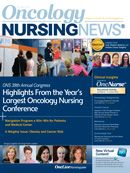Compassion Fatigue and the Challenge of Developing Resilience
If the job of oncology nurse comes with satisfactions it also comes with an abundance of stress, even more than what oncologists and other medical professionals experience, according to research.
Penny Damaskos,
PhD, LCSW, OSW-C
If the job of oncology nurse comes with satisfactions— the gratitude from patients and family members for compassionate care rendered, shared happiness with patients who experience good outcomes— it also comes with an abundance of stress, even more than what oncologists and other medical professionals experience, according to research.
The stress can lead to burnout and to “compassion fatigue,” compromising job satisfaction and careers, and damaging personal lives.
Because they are working with patients “at one of the most significant times of their lives,” it is common for oncology nurses to develop an unusual closeness, said Penny Damaskos, PhD, LCSW, OSW-C, program coordinator and clinical supervisor at Memorial Sloan-Kettering Cancer Center (MSKCC), speaking as part of a panel on compassion fatigue at the 38th Annual ONS Congress.
Physical symptoms as well as psychological ones may appear in nurses as a result, often with impacts both at home and at work—where lowered productivity, increased work absenteeism, or leaving the work setting altogether have been reported under these circumstances (Table).
Table. Symptoms of Compassion Fatigue1
Lowered frustration tolerance/increased outbursts of anger or rage
Avoidance of contact with patients
Self-destructive, self-loathing behaviors
Difficulty separating work from personal life
Patient’s suffering mirrored in helper (eg, loss of hope, intrusive thoughts, feelings of helplessness)
Blurring of professional boundaries
Damaskos and others on the panel discussed how compassion fatigue arises from the desire to relieve another person’s suffering. Differing from “burnout” which is grounded in nurses’ reaction to the work environment (although there are shared symptoms), compassion fatigue has its source in the clinical work itself, and in the manner by which nurses internalize interactions with patients. For an oncology nurse, interactions with cancer patients, especially those who are hospitalized, often conclude with loss (of patients to death) and to internalized grief. From constant exposure to the suffering of fellow human beings, nurses may develop feelings of helplessness.
The scope and range of recent published research on compassion fatigue and burnout are evidence of the urgency of these issues to the field of oncology nursing. A search using Google Scholar returned 493 results since 2009, according to panelist Katherine Janzen, RN, MN, ONC-C, assistant professor, School of Nursing at Mount Royal University in Calgary, Canada. Proquest and the Allied Health Database contain 284 articles on compassion fatigue in oncology nurses. Among themes that recur is the recognition of compassion fatigue as an imperative nursing agenda item for action and intervention.
Katrina Fetter, BSN, RN, OCN
Panelist Katrina Fetter, BSN, RN, OCN, staff nurse and assistant manager at Lancaster General Hospital in Pennsylvania, pointed to her institution’s successful strategies to deal with compassion fatigue. Lessons from this experience, she said, include instituting an open dialogue with staff on the subject of stress and its consequences and a process of regular reevaluation. Build a formal program that is supported by the literature, Fetter advised, but “remain flexible,” to better respond to specific problems as they arise.
The end goal for nurses, said Fetter, is to develop healthy, therapeutic relationships with patients, but also to protect themselves by cultivating emotional boundaries.
Memorial Sloan-Kettering Cancer Center has incorporated within its system an “institution-wide” push toward recognition of staff burnout and promotion of wellness, said Damaskos. Institution-wide seminars and respite programs and a partnership between Employee Wellness and the Department of Social Work have been incorporated within the hospital system. At the level of the individual, she said, there are support groups on inpatient units and in outpatient facilities to address job stressors, and these services are available to all staff.
Among several other initiatives at MSKCC, Damaskos described an ambulatory nursing program, which has explored such topics as “Bereavement: Coping for Healthcare Professionals,” “Therapeutic Communication: Discussions about Death and Dying,” and “Compassion Fatigue, Burnout and Resilience.” Also at MSKCC, a peer-to-peer pilot project has been launched for nurses to promote self-awareness of the impact of their work and to serve as an opportunity for discussion of topics central to maximizing their productivity, sensitivity, and resilience— including maintaining positivity, fostering emotional insight, and life balance and spirituality.
Strategies for Developing Resilience2
Cultivate a healthy work-life balance: leave work at work, recognizing that compassion fatigue and burnout are part of the job description. Allow for respite times within work days as well as outside of work.
Build supportive professional relationships and networks through professional and educational support systems (eg, mentors).
Develop reliable “sounding boards” in professional and personal life. Get involved in projects that interest you. Focus on mentoring others.
References
- Gentry JE, Baranowsky AB, Dunning K. ARP: the accelerated recovery program (ARP) for compassion fatigue. In: Figley CR, editor. Treating Compassion Fatigue. New York: Brunner-Routledge; 2002:123-137.
- Jackson D, Firtko A, Edenborough M. Personal resilience as a strategy for surviving and thriving in the face of workplace adversity: a literature review. J Adv Nurs. 2007;60(1):1-9.




